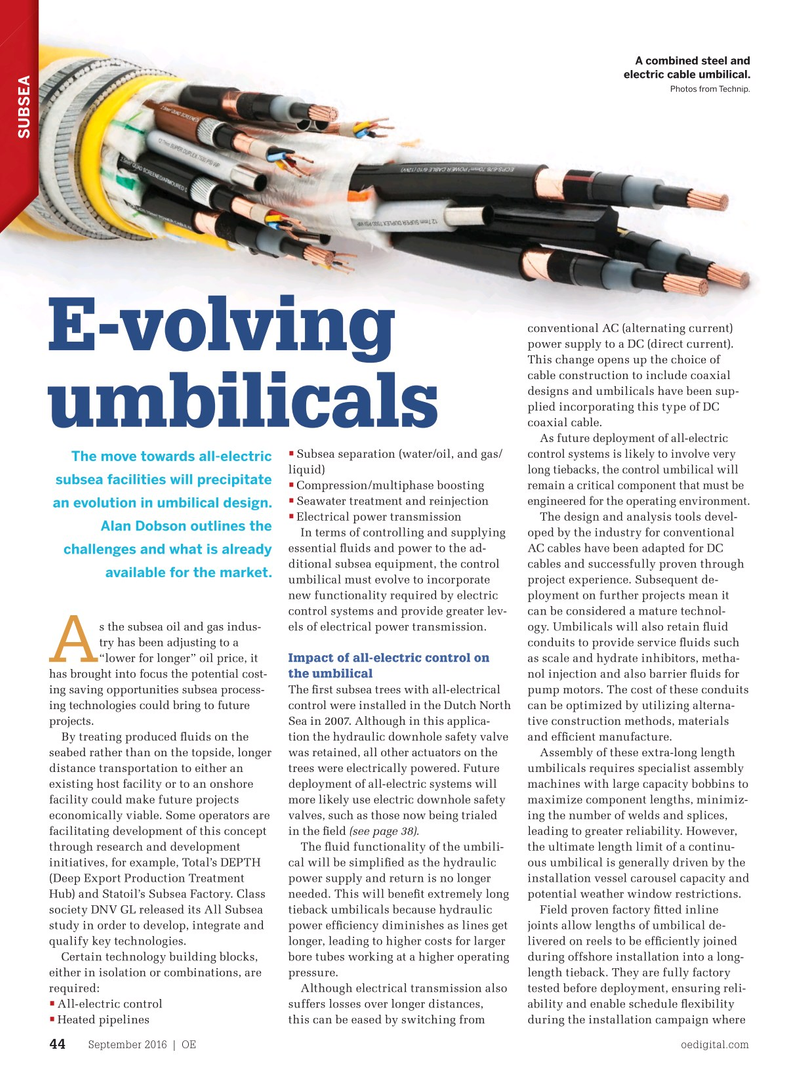
Page 42: of Offshore Engineer Magazine (Sep/Oct 2016)
Read this page in Pdf, Flash or Html5 edition of Sep/Oct 2016 Offshore Engineer Magazine
A combined steel and electric cable umbilical.
Photos from Technip.
SUBSEA conventional AC (alternating current) power supply to a DC (direct current).
E-volving
This change opens up the choice of cable construction to include coaxial designs and umbilicals have been sup- plied incorporating this type of DC coaxial cable.
umbilicals
As future deployment of all-electric
Subsea separation (water/oil, and gas/ • control systems is likely to involve very
The move towards all-electric liquid) long tiebacks, the control umbilical will subsea facilities will precipitate • Compression/multiphase boosting remain a critical component that must be
Seawater treatment and reinjection • engineered for the operating environment. an evolution in umbilical design.
Electrical power transmission The design and analysis tools devel- •
Alan Dobson outlines the
In terms of controlling and supplying oped by the industry for conventional essential ? uids and power to the ad- AC cables have been adapted for DC challenges and what is already ditional subsea equipment, the control cables and successfully proven through available for the market. umbilical must evolve to incorporate project experience. Subsequent de- new functionality required by electric ployment on further projects mean it control systems and provide greater lev- can be considered a mature technol- s the subsea oil and gas indus- els of electrical power transmission. ogy. Umbilicals will also retain ? uid try has been adjusting to a conduits to provide service ? uids such
A Impact of all-electric control on “lower for longer” oil price, it as scale and hydrate inhibitors, metha- the umbilical has brought into focus the potential cost- nol injection and also barrier ? uids for ing saving opportunities subsea process- The ? rst subsea trees with all-electrical pump motors. The cost of these conduits ing technologies could bring to future control were installed in the Dutch North can be optimized by utilizing alterna- projects. Sea in 2007. Although in this applica- tive construction methods, materials
By treating produced ? uids on the tion the hydraulic downhole safety valve and ef? cient manufacture.
seabed rather than on the topside, longer was retained, all other actuators on the Assembly of these extra-long length distance transportation to either an trees were electrically powered. Future umbilicals requires specialist assembly existing host facility or to an onshore deployment of all-electric systems will machines with large capacity bobbins to facility could make future projects more likely use electric downhole safety maximize component lengths, minimiz- economically viable. Some operators are valves, such as those now being trialed ing the number of welds and splices, facilitating development of this concept in the ? eld (see page 38). leading to greater reliability. However, through research and development The ? uid functionality of the umbili- the ultimate length limit of a continu- initiatives, for example, Total’s DEPTH cal will be simpli? ed as the hydraulic ous umbilical is generally driven by the (Deep Export Production Treatment power supply and return is no longer installation vessel carousel capacity and
Hub) and Statoil’s Subsea Factory. Class needed. This will bene? t extremely long potential weather window restrictions. society DNV GL released its All Subsea tieback umbilicals because hydraulic Field proven factory ? tted inline study in order to develop, integrate and power ef? ciency diminishes as lines get joints allow lengths of umbilical de- qualify key technologies. longer, leading to higher costs for larger livered on reels to be ef? ciently joined
Certain technology building blocks, bore tubes working at a higher operating during offshore installation into a long- either in isolation or combinations, are pressure. length tieback. They are fully factory required: Although electrical transmission also tested before deployment, ensuring reli- •
All-electric control suffers losses over longer distances, ability and enable schedule ? exibility • Heated pipelines this can be eased by switching from during the installation campaign where
September 2016 | OE oedigital.com 44 044_OE0916_Subsea2_Technip.indd 44 8/24/16 1:10 PM

 41
41

 43
43